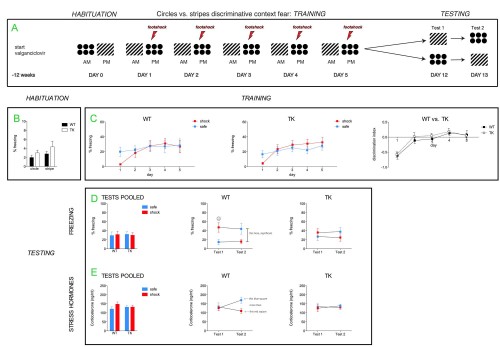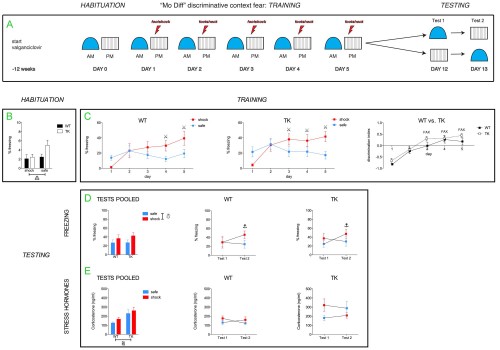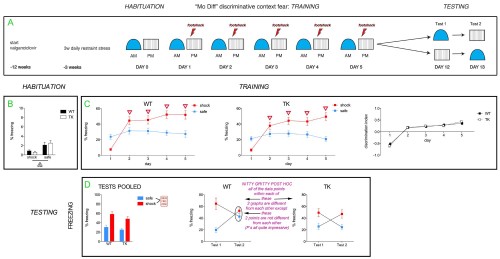One of the leading hypothesized functions for adult hippocampal neurogenesis in memory is pattern separation. Loosely defined, pattern separation is the process of making similar patterns of neural activity more distinct. This is clearly relevant for learning and memory since we have many experiences that are similar to each other but nonetheless must be remembered as distinct. For example, the girl who sat behind me in 2nd year organic chemistry bore a striking similarity to the woman who later became the mother of my firstborn child (long, dark curly hair, sense of humour etc). But perhaps due to a dysfunctional hippocampus it wasn’t until halfway through the term that I was able to discriminate these 2 individuals.
In its true form, pattern separation is a neurophysiological computation that is very difficult to measure since we know very little about how information is represented, in terms of action potential firing patterns in assemblies of cells (i.e. how can you measure how information has changed if you don’t have a good handle on what the incoming neural activity meant in the first place?). There has been some progress suggesting the dentate gyrus may pick up on minor changes in the environment and perform such a function. And so behaviourists have been keen to test whether the dentate gyrus and immature neurons are important for this function, using tasks such as discriminative context fear conditioning (is this the place where I received a shock?) or object location tests (did these objects move just a tiny bit since I saw them last?). When the dentate gyrus is compromised, or when neurogenesis is reduced, we sometimes see deficits in these behaviours. If you have a look at the pattern separation blog you’ll see an impressive interdisciplinary discussion of what these findings mean (and don’t mean!). In short, they are consistent with a pattern separation role but they don’t prove that the dentate is actually performing pattern separation at a physiological level.
Here I present some new data on adult neurogenesis, context fear discrimination, and stress hormones. It’s been on my hard drive since 2008. Which is ridiculous since it reflects many long days of putting mice into boxes and the findings are pretty intriguing, if inconclusive.
So finally I wrote it up and have published it on Figshare. Download it there and read along.
The basic idea is that I was training neurogenesis-deficient GFAP-TK mice in a discriminative context fear paradigm. The hypothesis was that, if the dentate gyrus and adult neurogenesis is important for pattern separation, then we would expect that the TK mice would be impaired, and show similar levels of freezing in the so-called “safe” and “shock” contexts. This is now obvious given work by McHugh, Tronel, Sahay, Niibori, Kheirbeck.
To make the discrimination challenging, I started with a discrimination paradigm where the 2 contexts were quite similar and the only difference was the pattern on the walls of the 2 contexts: circles or stripes. During the training session it appeared to be too challenging – the mice showed no discrimination whatsoever. Interesting finding #1: when tested 1 week later, the WT mice did show a discrimination whereas the TK mice did not. To get the most out of the experiment, I re-tested the mice the following day: mice that were tested in the shock context on test 1 were tested in the safe context on test 2 and vice versa. Interesting finding #2: There was a carry over effect such that the WT mice again discriminated, but on test 2 they now froze more in the safe context! On test 2 corticosterone levels were also greater in the mice tested in the safe context.
This experiment (“Circles vs Stripes”) suggests to me that neurogenesis may indeed be involved in some sort of pattern separation function, since the TK mice never successfully discriminated. But it is interesting that WT mice only discriminated during the test. Usually, context fear memories become more generalized with time (see Wiltgen, Biedenkapp, Wang) but here they are becoming more accurate. I don’t have a solid explanation for this but wonder if the simplicity of the context difference plays a role. If mice were able to form a simple stimulus-shock association (circle-shock or stripe-shock association, rather than complex context-shock association) then these memories might not subject to the same generalization/interference processes that typically occur during consolidation. This result is also a reminder that memory may be intact, even when there isn’t behavioural evidence. Regarding the reversal effect, the paradigm is different but reminiscent of findings by Beracochea showing that stress can alter which of 2 context memories dominates at the time of retrieval. It is also worth noting that blood samples were taken 30min after testing for corticosterone measurements, using a submandibular cheek-lancet method. This is a stressful procedure and may have altered the memory retrieved on test #1, and contributed to the carryover effect on test #2.
To see if we could pull out a context discrimination difference during training, I repeated the experiment but changed many more features between the 2 contexts (shape, odours etc). This variation was code named MO DIFF since the contexts were made “more different” and I have kept that name since this isn’t a journal. If anything, the TK mice now did a better job of discriminating (at least during training). Compared to Circles vs Stripes there was weaker discrimination during Mo Diff testing and also fewer reversal/carryover effects between tests #1 and #2. TK mice had huge elevations in corticosterone compared to WT mice at the time of fear memory retrieval.
For the last experiment I had some mice that had been subjected to chronic stress so I figured why not then test them on Mo Diff? The mice in Mo Diff didn’t remember super well and chronic stress enhances fear conditioning so…we found that these mice indeed discriminated very well during training and testing. No difference between WT and TK mice during training but TK mice discriminated identically on tests #1 and #2. In contrast, WT mice again showed a carryover effect such that there was no discrimination on test #2.
——————————————–
Final thoughts: This dataset may raise more questions than it answers and for this reason my work with GFAP-TK mice then took a more straightforward route, eliminating memory from the equation and investigating whether new neurons are important for innate responses to psychological stress. In any case:
- The data support a role for neurogenesis in context discrimination, and potentially pattern separation, but it suggests that new neurons may bias towards both separation or generalization depending on the conditions.
- New neurons may be important for accurate consolidation of memory
- Neurogenesis regulates stress hormone levels during memory retrieval
- Testing order strongly influences whether mice express fear in the appropriate context
Reference: Snyder, Jason; Cameron, Heather A. (2013): Reduced adult neurogenesis alters behavioural and endocrine discriminative fear conditioning. figshare.
http://dx.doi.org/10.6084/m9.figshare.884597


